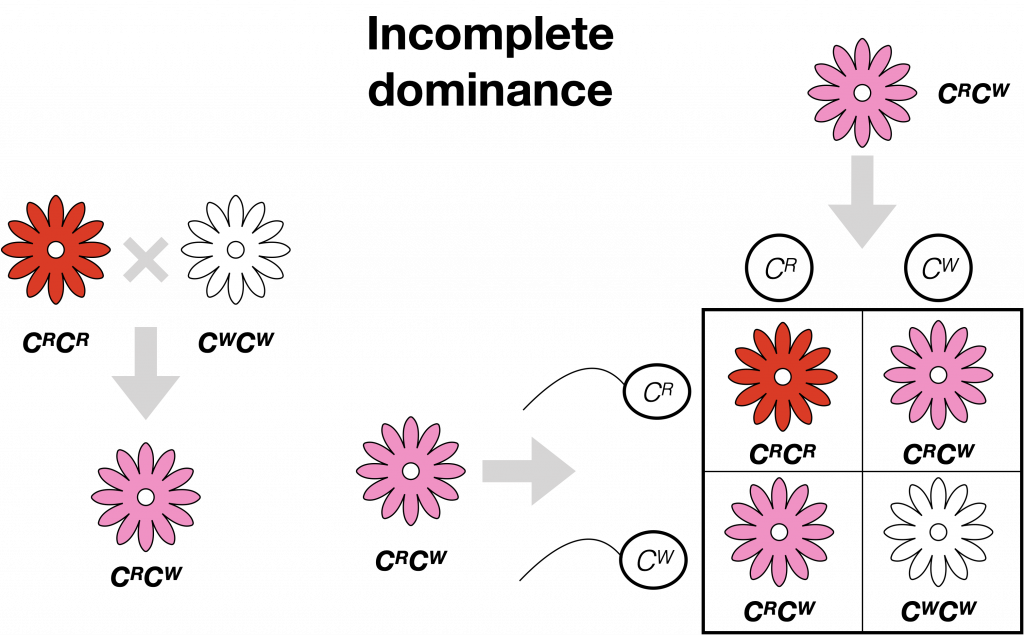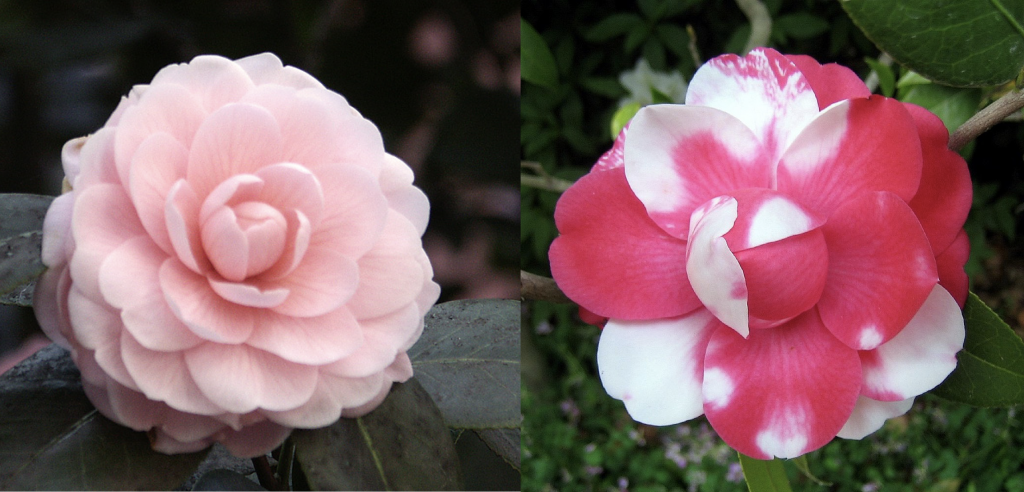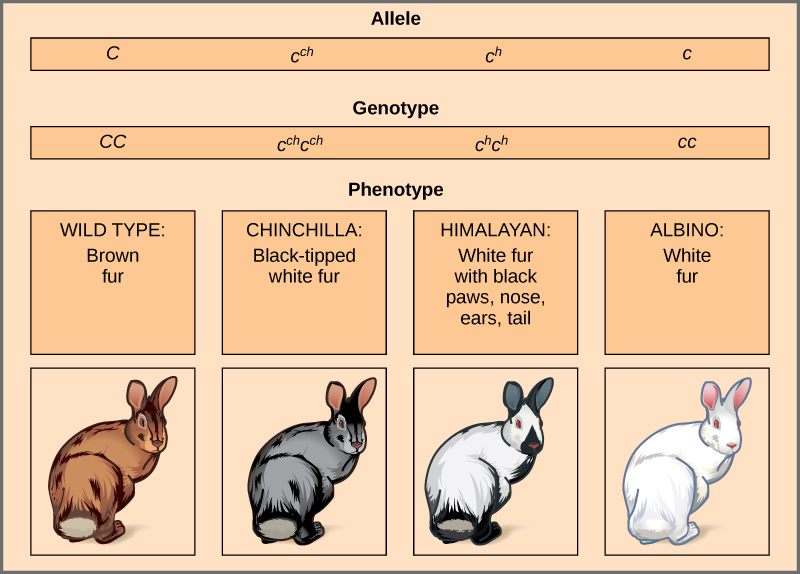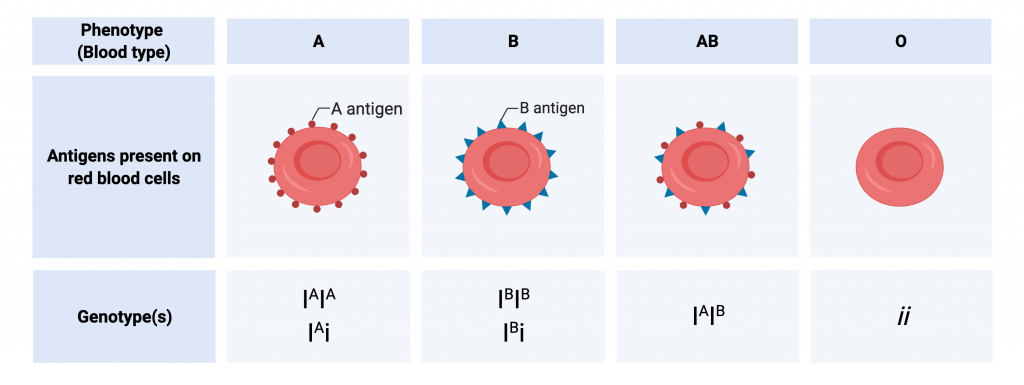20.1 Incomplete Dominance, Codominance, and Multiple Alleles
Alternatives to Dominance and Recessiveness
Mendel’s experiments with pea plants suggested that: (1) two “units” or copies exist for every gene; (2) alleles maintain their integrity in each generation (no blending); and (3) in the presence of the dominant allele, the recessive allele is hidden and makes no contribution to the phenotype. Therefore, recessive alleles can be “carried” and not expressed by individuals. Such heterozygous individuals are sometimes referred to as “carriers.” Further genetic studies in other plants and animals have shown that much more complexity exists, but that the fundamental principles of Mendelian genetics still hold true. In the sections to follow, we consider some of the complexity.
Incomplete Dominance
Mendel’s results, that traits are inherited based on dominant and recessive alleles of a particular gene, contradicted the view at that time that offspring exhibited a blend of their parents’ traits. However, the heterozygote phenotype sometimes does appear to be intermediate between the two parents.

For example, in the snapdragon, Antirrhinum majus, a cross between a homozygous parent with white flowers (CWCW) and a homozygous parent with red flowers (CRCR) will produce offspring with pink flowers (CRCW). (Note that different genotypic abbreviations are often used for Mendelian extensions to distinguish these patterns from simple dominance and recessiveness.) This pattern of inheritance is described as incomplete dominance. The allele for red flowers is incompletely dominant over the allele for white flowers. The results of a cross can still be predicted and diagrammed using a Punnett Square, just as with Mendelian dominant and recessive crosses. In this case, the genotypic ratio would be 1 CRCR:2 CRCW:1 CWCW, and the phenotypic ratio would be 1:2:1 for red:pink:white.
Codominance
Sometimes both alleles of a particular gene are expressed in a dominant fashion, meaning both alleles for the same characteristic are simultaneously expressed in the heterozygote. This is called codominance. Some flowering plants display this type of inheritance. For example, Camellia flowers can show patches of pink and white on the same flower.

Multiple Alleles
Individual humans, and all diploid individuals of other species, will have two copies of each gene (both copies might be the same, or there can be one copy each of two different alleles). However, at the population level, there are often more than two different alleles for a given gene. In this case, many combinations of two alleles are observed among the individuals of a population. Note that when many alleles exist for the same gene, the convention is to denote the most common phenotype or genotype among wild organisms of the species as the wild type (often abbreviated “+”); this is considered the standard or norm. Variants may be recessive or dominant to the wild-type allele.
An example of multiple alleles is coat color in rabbits. Here, four alleles exist for the C gene. The wild-type phenotype (brown fur) is encoded by the C+ allele, the chinchilla phenotype (black-tipped white fur) is encoded by the cch allele, the Himalayan phenotype (black fur on the extremities and white fur elsewhere) is encoded by the ch allele, and the albino phenotype (white fur) is encoded by the c allele.In cases of multiple alleles, dominance hierarchies can exist. In this case, the wild-type allele is dominant over all the others, chinchilla is dominant over Himalayan and albino, and Himalayan is dominant over albino.

The complete dominance of a wild-type phenotype over all others often occurs as an effect of “dosage” of a specific gene product, such that the wild-type allele supplies the correct amount of gene product whereas the mutant alleles cannot. For the allelic series in rabbits, the wild-type allele may supply a given dosage of fur pigment, whereas the mutants supply a lesser dosage or none at all. Interestingly, the Himalayan phenotype is the result of an allele that produces a temperature-sensitive gene product that only produces pigment in the cooler extremities of the rabbit’s body.
Another example of multiple alleles, as well as codominance, determines the ABO blood type in humans. The A and B phenotypes are based on the presence of the A and B antigens, respectively, which are present on the surface of red blood cells. There are three alleles: IA, IB, and i. Alleles IA and IB are codominant with respect to one another, and both are dominant to i.

when the phenotype of the heterozygote displays a distinct, intermediate phenotype between the two homozygotes
in a heterozygote, complete and simultaneous expression of both alleles for the same characteristic

